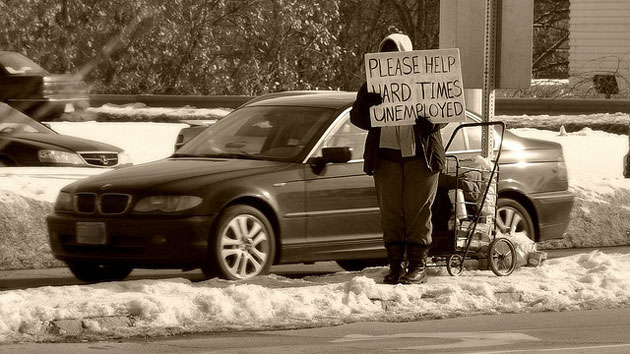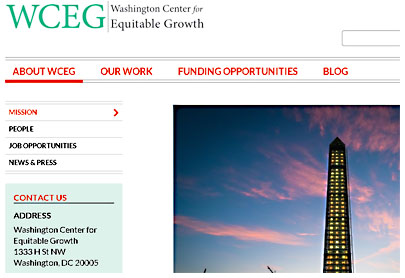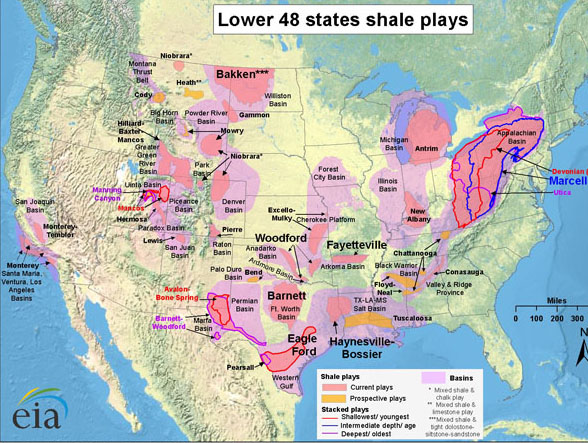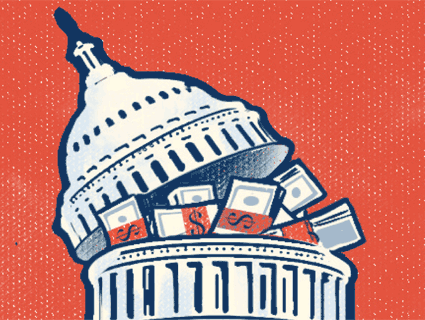
<a href="https://www.flickr.com/photos/jronaldlee/4295393921/in/photolist-7xz1XT-7zzPt2">James Lee</a>/Flickr
This story first appeared on the TomDispatch website.
Last year eight Americans—the four Waltons of Walmart fame, the two Koch brothers, Bill Gates, and Warren Buffett—made more money than 3.6 million American minimum-wage workers combined. The median pay for CEOs at America’s large corporations rose to $10 million per year, while a typical chief executive now makes about 257 times the average worker’s salary, up sharply from 181 times in 2009. Overall, 1 percent of Americans own more than a third of the country’s wealth.
As the United States slips from its status as the globe’s number one economic power, small numbers of Americans continue to amass staggering amounts of wealth, while simultaneously inequality trends toward historic levels. At what appears to be a critical juncture in our history and the history of inequality in this country, here are nine questions we need to ask about who we are and what will become of us. Let’s start with a French economist who has emerged as an important voice on what’s happening in America today.
1) What does Thomas Piketty have to do with the 99 percent?
French economist Thomas Piketty’s surprise bestseller, Capital in the Twenty-First Century, is an unlikely beach read, though it’s selling like one. A careful parsing of massive amounts of data distilled into “only” 700 pages, it outlines the economic basis for the 1 percent-99 percent divide in the United States. (Conservative critics, of course, disagree.)
Just in case you aren’t yet rock-bottom certain about the reality of that divide, here are some stats: the top 1 percent of Americans hold 35 percent of the nation’s net worth; the bottom 80 percent, only 11 percent. The United States has such an unequal distribution of wealth that, in global rankings, it falls among the planet’s kleptocracies, not the developed nations that were once its peers. The mathematical measure of wealth-inequality is called “Gini,” and the higher it is, the more extreme a nation’s wealth-inequality. The Gini for the U.S. is 85; for Germany, 77; Canada, 72; and Bangladesh, 64. Nations more unequal than the U.S. include Kazakhstan at 86 and the Ukraine at 90. The African continent tips in at just under 85. Odd company for the self-proclaimed “indispensable nation.”
Piketty shows that such inequality is driven by two complementary forces. By owning more of everything (capital), rich people have a mechanism for getting ever richer than the rest of us, because the rate of return on investment is higher than the rate of economic growth. In other words, money made from investments grows faster than money made from wages. Piketty claims the wealth of the wealthiest Americans is rising at 6-7 percent a year, more than three times as fast as the economy the rest of us live in.
At the same time, wages for middle and lower income Americans are sinking, driven by factors also largely under the control of the wealthy. These include the application of new technology to eliminate human jobs, the crushing of unions, and a decline in the inflation-adjusted minimum wage that more and more Americans depend on for survival.
The short version: A rising tide lifts all yachts.
2) So why don’t the unemployed/underemployed simply find better jobs?
Another way of phrasing this question is: Why don’t we just blame the poor for their plight? Mention unemployment or underemployment and someone will inevitably invoke the old “pull yourself up by your bootstraps” line. If workers don’t like retail or minimum-wage jobs, or if they can’t find good paying jobs in their area, why don’t they just move? Quit retail or quit Pittsburgh (Detroit, Cleveland, St. Louis) and…
Move to where to do what? Our country lost one-third of all decent factory jobs—almost six million of them—between 2000 and 2009, and wherever “there” is supposed to be, piles of people are already in line. In addition, many who lost their jobs don’t have the means to move or a friend with a couch to sleep on when they get to Colorado. Some have lived for generations in the places where the jobs have disappeared. As for the jobs that are left, what do they pay? One out of four working Americans earn less than $10 per hour. At 25 percent, the US has the highest percentage of low-wage workers in the developed world. (Canada and Great Britain have 20 percent, Japan under 15 percent, and France 11 percent.)
One in six men, 10.4 million Americans aged 25 to 64, the prime working years, don’t have jobs at all, a portion of the male population that has almost tripled in the past four decades. They are neither all lazy nor all unskilled, and at present they await news of the uncharted places in the U.S. where those 10 million unfilled jobs are hidden.
Moving “there” to find better work isn’t an option.
3) But aren’t there small-scale versions of economic “rebirths” occurring all over America?
Travel through some of the old Rust Belt towns of this country and you’ll quickly notice that “economic rebirth” seems to mean repurposing buildings that once housed factories and shipping depots as bars and boutiques. Abandoned warehouses are now trendy restaurants; a former radiator factory is an artisanal coffee shop. In other words, in a place where a manufacturing plant once employed hundreds of skilled workers at union wages, a handful of part-timers are now serving tapas at minimum wage plus tips.
In Maryland, an ice cream plant that once employed 400 people with benefits and salaries pegged at around $40,000 a year closed its doors in 2012. Under a “rebirth” program, a smaller ice cream packer reopened the place with only 16 jobs at low wages and without benefits. The new operation had 1,600 applicants for those 16 jobs. The area around the ice cream plant once produced airplanes, pipe organs, and leather car seats. No more. There were roughly 14,000 factory jobs in the area in 2000; today, there are 8,000.
General Electric’s Appliance Park, in Louisville, Kentucky, employed 23,000 union workers at its peak in 1973. By 2011, the sputtering plant held onto only about 1,800 workers. What was left of the union there agreed to a two-tier wage scale, and today 70 percent of the jobs are on the lower tier—at $13.50 an hour, almost $8 less than what the starting wage used to be. A full-time worker makes about $28,000 a year before taxes and deductions. The poverty line for a family of four in Kentucky is $23,000. Food stamp benefits are available to people who earn up to 130 percent of the poverty line, so a full-timer in Kentucky with a family still qualifies. Even if a worker moved to Kentucky and lucked out by landing a job at the plant, standing on your tiptoes with your lips just above sea level is not much of a step up.
Low paying jobs are not a rebirth.
4) Can’t people just get off their couches and get back to work?
There are 3.8 million Americans who have been out of work for 27 weeks or more. These are the country’s long-term unemployed, as defined by the Department of Labor. Statistically, the longer you are unemployed, the less likely it is that you’ll ever find work again. Between 2008 and 2012, only 11 percent of those unemployed 15 months or more found a full-time job, and research shows that those who do find a job are less likely to retain it. Think of it as a snowball effect: more unemployment creates more unemployable people.
 And how hard is it to land even a minimum-wage job? This year, the Ivy League college admissions acceptance rate was 8.9 percent. Last year, when Walmart opened its first store in Washington, D.C., there were more than 23,000 applications for 600 jobs, which resulted in an acceptance rate of 2.6 percent, making the big box store about twice as selective as Harvard and five times as choosy as Cornell.
And how hard is it to land even a minimum-wage job? This year, the Ivy League college admissions acceptance rate was 8.9 percent. Last year, when Walmart opened its first store in Washington, D.C., there were more than 23,000 applications for 600 jobs, which resulted in an acceptance rate of 2.6 percent, making the big box store about twice as selective as Harvard and five times as choosy as Cornell.
Telling unemployed people to get off their couches (or out of the cars they live in or the shelters where they sleep) and get a job makes as much sense as telling them to go study at Harvard.
5) Why can’t former factory workers retrain into new jobs?
Janesville, Wisconsin, had the oldest General Motors car factory in America, one that candidate Obama visited in 2007 and insisted would be there for another 100 years. Two days before Christmas that year and just before Obama’s inauguration, the plant closed forever, throwing 5,000 people out of work. This devastated the town, because you either worked in the plant or in a business that depended on people working in the plant. The new president and Congress quickly paid for a two-million-dollar Janesville retraining program, using state community colleges the way the government once used trade schools built to teach new immigrants the skills needed by that Janesville factory a century ago.
This time around, however, those who finished their retraining programs simply became trained unemployables rather than untrained ones. It turned out that having a certificate in “heating and ventilation” did not automatically lead to a job in the field. There were already plenty of people out there with such certificates, never mind actual college degrees. And those who did find work in some field saw their take-home pay drop by 36 percent. This, it seems, is increasingly typical in twenty-first-century America (though retraining programs have been little studied in recent years).
Manufacturing is dead and the future lies in a high-tech, information-based economy, some say. So why can’t former factory workers be trained to do that? Maybe some percentage could, but the U.S. graduated 1,606,000 students with bachelor’s degrees in 2014, many of whom already have such skills.
Bottom Line: Jobs create the need for training. Training does not create jobs.
6) Shouldn’t we cut public assistance and force people into the job market?
At some point in any discussion of jobs, someone will drop the nuclear option: cut federal and state benefits and do away with most public assistance. That’ll motivate people to find jobs—or starve. Unemployment money and food stamps (now called the Supplemental Nutrition Assistance Program, or SNAP) encourage people to be lazy. Why should tax dollars be used to give food to people who won’t work for it? “If you’re able-bodied, you should be willing to work,” House Majority Leader Eric Cantor said discussing food stamp cuts.
The problem with such statements is 73 percent of those enrolled in the country’s major public benefits programs are, in fact, from working families—just in jobs whose paychecks don’t cover life’s basic necessities. McDonald’s workers alone receive $1.2 billion in federal assistance per year.
Why do so many of the employed need food stamps? It’s not complicated. Workers in the minimum-wage economy often need them simply to survive. All in all, 47 million people get SNAP nationwide because without it they would go hungry.
In Ohio, where I did some of the research for my book Ghosts of Tom Joad, the state pays out benefits on the first of each month. Pay Day, Food Day, Mother’s Day, people call it. SNAP is distributed in the form of an Electronic Bank Transfer card, or EBT, which, recipients will tell you, stands for “Eat Better Tonight.” EBT-friendly stores open early and stay open late on the first of the month because most people are pretty hungry come the Day.
A single person with nothing to her name in the lower 48 states would qualify for no more than $189 a month in SNAP. If she works, her net monthly income is multiplied by .3, and the result is subtracted from the maximum allotment. Less than fifty bucks a week for food isn’t exactly luxury fare. Sure, she can skip a meal if she needs to, and she likely does. However, she may have kids; almost two-thirds of SNAP children live in single-parent households. Twenty percent or more of the child population in 37 states lived in “food insecure households” in 2011, with New Mexico (30.6 percent) and the District of Columbia (30 percent) topping the list. And it’s not just kids. Households with disabled people account for 16 percent of SNAP benefits, while 9 percent go to households with senior citizens.
Almost 22 percent of American children under age 18 lived in poverty in 2012; for those under age five, it’s more than 25 percent. Almost 1 in 10 live in extreme poverty.
Our system is trending toward asking kids (and the disabled, and the elderly) to go to hell if they’re hungry. Many are already there.
7) Why are Walmart and other businesses opposed to SNAP cuts?
Public benefits are now a huge part of the profits of certain major corporations. In a filing with the Securities and Exchange Commission, Walmart was oddly blunt about what SNAP cuts could do to its bottom line:
“Our business operations are subject to numerous risks, factors, and uncertainties, domestically and internationally, which are outside our control. These factors include… changes in the amount of payments made under the Supplemental Nutrition Assistance Plan and other public assistance plans, [and] changes in the eligibility requirements of public assistance plans.”
How much profit do such businesses make from public assistance? Short answer: big bucks. In one year, nine Walmart Supercenters in Massachusetts received more than $33 million in SNAP dollars—more than four times the SNAP money spent at farmers’ markets nationwide. In two years, Walmart received about half of the one billion dollars in SNAP expenditures in Oklahoma. Overall, 18 percent of all food benefits money is spent at Walmart.
Pepsi, Coke, and the grocery chain Kroger lobbied for food stamps, an indication of how much they rely on the money. The CEO of Kraft admitted that the mac n’ cheese maker opposed food stamp cuts because users were “a big part of our audience.” One-sixth of Kraft’s revenues come from food stamp purchases. Yum Brands, the operator of KFC, Taco Bell, and Pizza Hut, tried to convince lawmakers in several states to allow its restaurants to accept food stamps. Products eligible for SNAP purchases are supposed to be limited to “healthy foods.” Yet lobbying by the soda industry keeps sugary drinks on the approved list, while companies like Coke and Pepsi pull in four billion dollars a year in revenues from SNAP money.
Poverty is big business.
8) Should We Raise the Minimum Wage?
One important reason to raise the minimum wage to a living one is that people who can afford to feed themselves will not need food stamps paid for by taxpayers. Companies who profit off their workers’ labor will be forced to pay a fair price for it, and not get by on taxpayer-subsidized low wages. Just as important, people who can afford to feed themselves earn not just money, but self-respect. The connection between working and taking care of yourself and your family has increasingly gone missing in America, creating a society that no longer believes in itself. Rock bottom is a poor foundation for building anything human.
But won’t higher wages cause higher prices? The way taxpayers functionally subsidize companies paying low-wages to workers—essentially ponying up the difference between what McDonald’s and its ilk pay and what those workers need to live via SNAP and other benefits—is a hidden cost squirreled away in plain sight. You’re already paying higher prices via higher taxes; you just may not know it.
Even if taxes go down, won’t companies pass on their costs? Maybe, but they are unlikely to be significant. For example, if McDonald’s doubled the salaries of its employees to a semi-livable $14.50 an hour, not only would most of them go off public benefits, but so would the company—and yet a Big Mac would cost just 68 cents more. In general, only about 20 percent of the money you pay for a Big Mac goes to labor costs. At Walmart, increasing wages to $12 per hour would cost the company only about one percent of its annual sales.
Despite labor costs not being the most significant factor in the way low-wage businesses set their prices, one of the more common objections to raising the minimum wage is that companies, facing higher labor costs, will cut back on jobs. Don’t believe it.
The Los Angeles Economic Round Table concluded that raising the hourly minimum to $15 in that city would generate an additional $9.2 billion in annual sales and create more than 50,000 jobs. A Paychex/IHS survey, which looks at employment in small businesses, found that the state with the highest percentage of annual job growth was Washington, which also has the highest statewide minimum wage in the nation. The area with the highest percentage of annual job growth was San Francisco, the city with the highest minimum wage in the nation. Higher wages do not automatically lead to fewer jobs. Many large grocery chains, including Safeway and Kroger, are unionized and pay well-above-minimum wage. They compete as equals against their non-union rivals, despite the higher wages.
Will employers leave a state if it raises its minimum wage independent of a nationwide hike? Unlikely. Most minimum-wage employers are service businesses that are tied to where their customers are. People are not likely to drive across state lines for a burger. A report on businesses on the Washington-Idaho border at a time when Washington’s minimum wage was nearly three bucks higher than Idaho’s found that the ones in Washington were flourishing.
While some businesses could indeed decide to close or cut back if the minimum wage rose, the net macro gains would be significant. Even a small hike to $10.10 an hour would put some $24 billion a year into workers’ hands to spend and lift 900,000 Americans above the poverty line. Consumer spending drives 70 percent of our economy. More money in the hands of consumers would likely increase the demand for goods and services, creating jobs.
Yes, raise the minimum wage. Double it or more. We can’t afford not to.
9) Okay, after the minimum wage is raised, what else can we do?
To end such an article, it’s traditional to suggest reforms, changes, solutions. It is, in fact, especially American to assume that every problem has a “solution.” So my instant suggestion: raise the minimum wage. Tomorrow. In a big way. And maybe appoint Thomas Piketty to the board of directors of Walmart.
But while higher wages are good, they are likely only to soften the blows still to come. What if the hyper-rich like being ever more hyper-rich and, with so many new ways to influence and control our political system and the economy, never plan to give up any of their advantages? What if they don’t want to share, not even a little more, not when it comes to the minimum wage or anything else?
The striking trend lines of social and economic disparity that have developed over the last 50 years are clearly no accident; nor have disemboweled unions, a deindustrialized America, wages heading for the basement (with profits still on the rise), and the widest gap between rich and poor since the slavery era been the work of the invisible hand. It seems far more likely that a remarkably small but powerful crew wanted it that way, knowing that a nation of fast food workers isn’t heading for the barricades any time soon. Think of it all as a kind of “Game of Thrones” played out over many years. A super-wealthy few have succeeded in defeating all of their rivals—unions, regulators, the media, honest politicians, environmentalists—and now are free to do as they wish.
What most likely lies ahead is not a series of satisfying American-style solutions to the economic problems of the 99 percent, but a boiling frog’s journey into a form of twenty-first-century feudalism in which a wealthy and powerful few live well off the labors of a vast mass of the working poor. Once upon a time, the original 99 percent, the serfs, worked for whatever their feudal lords allowed them to have. Now, Walmart “associates” do the same. Then, a few artisans lived slightly better, an economic step or two up the feudal ladder. Now, a technocratic class of programmers, teachers, and engineers with shrinking possibilities for upward mobility function similarly amid the declining middle class. Absent a change in America beyond my ability to imagine, that’s likely to be my future—and yours.
Peter Van Buren blew the whistle on State Department waste and mismanagement during Iraqi reconstruction in his first book, We Meant Well: How I Helped Lose the Battle for the Hearts and Minds of the Iraqi People. A Tom Dispatch regular, he writes about current events at his blog, We Meant Well. His new book, Ghosts of Tom Joad: A Story of the #99Percent, is available now.













